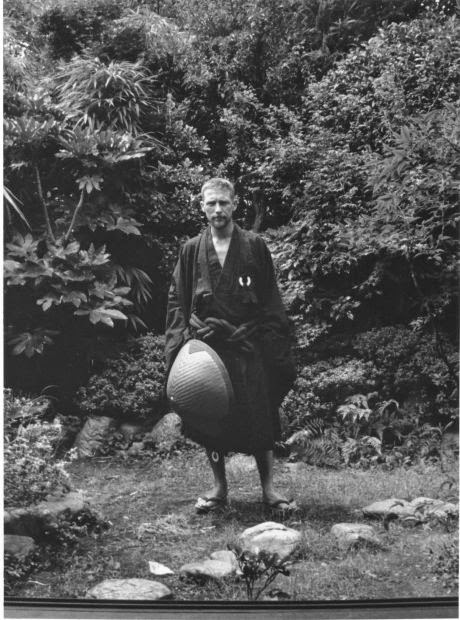I was in San Francisco for a couple of days last week, and of course I did
some walking while I was there. I know
the city somewhat but I often end up doing the same old things, so this time I (and
the Loved One) set out walking to a couple of places I’d never been before, the
Peace Pagoda in Japantown and the Villancourt Fountain in Justin Herman Plaza
near the downtown waterfront. Neither is
exactly obscure bit they’re not must-see destinations either.
The Peace Pagoda is in the Peace Plaza, part of the Japan Center complex, a cluster of Japanese shops
and restaurants. It was designed by the
architect Yoshiro Taniguchi and was a gift presented to San
Francisco in 1968 by Osaka, a “sister city” and the place where several members of Acid Mothers Temple come from.
The Peace Plaza is a big open paved space
between two malls, and although apparently it’s often the scene of concerts and
festivals, not much was going on when I was there: a couple of toddlers running
around under close parental supervision and a couple of Asian girls taking
selfies with the pagoda in the background.
Well, sure. I rather liked the
Peace Pagoda, for all that it’s part of an ancient tradition, but made of
concrete and it also looks a bit World’s Fair, a bit retro-futuristic. Who doesn’t like that?
And a small, curious thing I noticed around
Japantown, there were a number of signs for bars and restaurants that had
graphics of martini glasses outside. And
this was something I’d seen before in other parts of the city. San Francisco seems to have more martini signs
than any other city I’ve ever been in, and believe me I notice these things. Perhaps there’s a small monograph to be
written here. But we didn’t stop for a
martini, we went on to the Vaillancourt Fountain.
That empty, unused, paved expanse of the
Peace Plaza looked to have a lot in common with the Justin Herman Plaza. It’s also big and empty and people carefully
walk around the edges, leaving the center vacant. Maybe they’re keeping well away from the
Villancourt Fountain, a magnificent, brutal, concrete folly, and a controversial
one in certain circles. One Lloyd
Skinner, described as an “art connoisseur” said that the fountain was
"Stonehenge, unhinged, with plumbing troubles," but he seemed to
think that was a bad thing.
Judging its qualities is currently made harder
by the fact that the fountain is now dry.
Huge quantities of water were supposed to crash through the concrete
tubes 30,000 US gallons per minute, one reads, and this did, apparently, make a prodigious noise. But the fountain is expensive to run and in a
time of California drought maybe a giant water feature just doesn’t sit well
with locals.
As you see can probably see, the
structure contains various ramps and platforms, creating places you could stand
and watch the waters from above and even in their midst, but that’s no longer
possible. Even if there were any water, those
ramps and platforms are all barricaded off now.
There’s quite a lot of back
story to the fountain. Designer Armand
Vaillancourt, a French Canadian, sprayed “Quebec Libre” on the concrete of the fountain right before it was opened, and then
in 1987 U2 played a concert there and Bono (can that man do nothing right?)
sprayed "Rock N Roll Stops The Traffic" on it, which pissed off just
about everybody except Vaillancourt who is clearly one of nature’s genuine subversives,
and also a very sharp dressed man. That's him below.
Anyway there’s no sign of this aesthetic struggle now – and since
there’s no water running, and no noise, very few people seem to pay the fountain any mind
but this lack of water does mean you can walk right into it.
Kids seem to really like it, as a kind of adventure playground without
too much risk of injury. And I liked it
too, and found myself drawn in.
Of course as you walk under the mighty concrete arms you can’t help
thinking that if water were to come shooting out through the cavities at
unpredictable intervals, that would be truly adventurous, but the powers that
be in SF aren’t quite that subversive.
Anyway, by this time I was feeling in
need of the “silver bullet”. As the signs
prove, there are a great many paces to get a martini in this town but I only
really considered one of them, John’s Grill, beloved by Dashiell
Hammett and making an appearance in The
Maltese Falcon.
And you know, I was a little reluctant to
go there, a little scared of being disappointed. John’s was the place where I drank my first
ever American martini, and it holds a mythic spot in my life, but what if it
didn’t live up to my own personal mythology?
Anyway I risked it. I was a fool
to have worried. It was about 4.30 on a Saturday
afternoon, the place was dark and cool, and by no means empty, but there was only
one person sitting at the small bar. I
had my martini, the Loved One had a gimlet – and it was all pretty much perfect.
Drinking in the afternoon can always be a risky
thing, but this time it worked, we walked out of John’s with out spirits lifted
and a spring in our step. We also knew
that we were almost certainly walking in the footsteps of Hammett, who was
surely one of the sharpest dressed men ever to slouch in front of a typewriter
or indeed walk the mean streets.




























